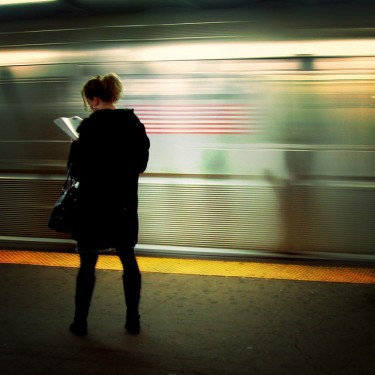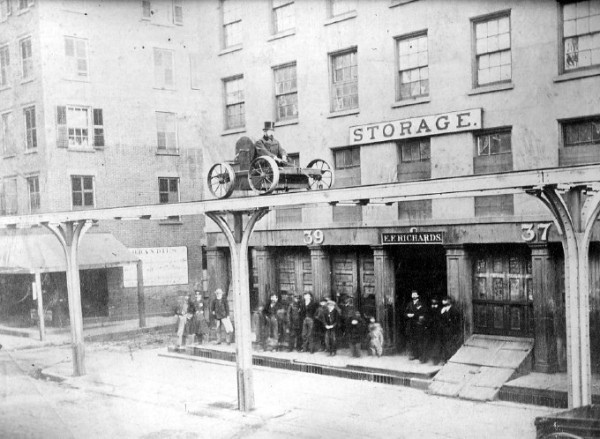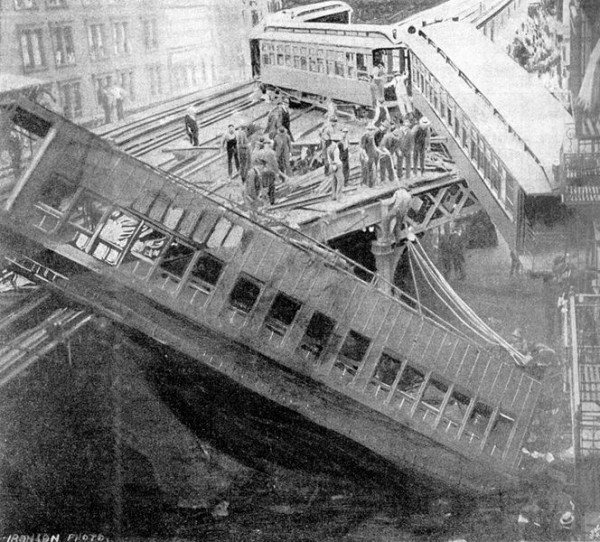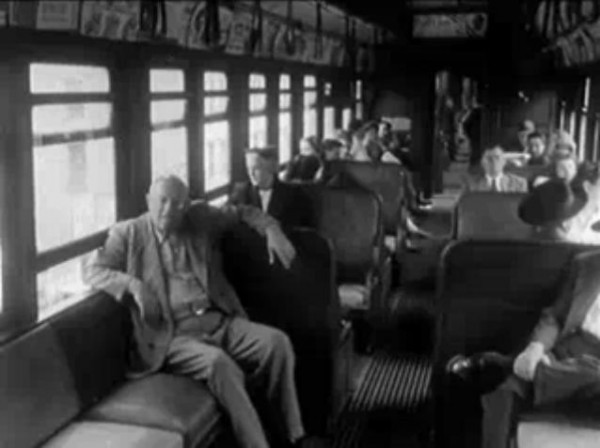How Much More Does Taking The Subway Cost Today?
How Much More Does Taking The Subway Cost Today?

It runs 24 hours a day — a rarity, anywhere in the world — and it moves 1.6 billion riders a year across the five boroughs of New York City. And on Friday (update: the new fare will be going into effect Sunday, March 3), it will become more expensive. After a fare hike five years ago, the base fare of taking the subway (that is with no discounts) will rise a quarter to $2.50 a pop. And although some of the service cuts enacted in 2010 have since been restored, this hike is not attached to any improvements in service — alas. As with other mandated fare hikes, this one was met with a resigned outrage, a sense that, boy, wouldn’t it be great if there was not going to be a hike even though we’re powerless to stop it?
This is a natural opportunity to ask the question, as we have concerning other elements of getting from one place to another in the big city: taking inflation into account, does it cost more today to take the subway that it has historically, or are we just a bunch of bellyachers?
***
The NYC subway is not the oldest (London!) or even the oldest in America (Boston!), but it definitely the predominate subway of the imagination, New Yorker or not, from Billy Strayhorn’s jazz standard to the The Taking of Pelham One Two Three, the system run by the Metropolitan Transit Authority is synonymous with ‘subway.’ Of course, this ubiquity is not necessarily positive, as the subways popularized by the aforementioned movie along with other gritty 70s movies set in New York City (and “The Warriors,” of course) was a grungy, overcrowded, vandalized commuting torture machine. Back in the pre-Giuliani Metropolis, the subways were emblematic of everything that made the city a place that the rest of the country think of it as a dangerous place: crime and litter, municipal dysfunction, impenetrable accents.
The subways did bounce back. Currently, they are largely clean, run largely on time. If not actually pleasant, they are largely tolerable, save on the random days of a “sick passenger” or “police investigation” (which are codes for “dead customer” and “suicide by train,” by the way) when you’re stuck on an unmoving train, or worse, an overcrowded platform, trying to remember how to forestall an incipient panic attack. It’s a big, complex system that’s more than a hundred years old, and Americans have the habit of being as bad at maintaining infrastructure as they are good at building it in the first place. Without the subway, the city is unmanageable.
And of course we in New York had the opportunity to see what a week without subways would be like, in days following the landfall of Sandy. Virtually every sub-river tunnel was flooded to the roof, with salt water, corrosive to the wiring and electrics. Somehow the MTA managed to restore rudimentary subway service in four days, and eighty percent of service in seven, by the beginning of the following work week. The period without service, it was what I’d imagine life was like before the subways, with residents sticking to walking, and inter-neighborhood transit being an extraordinary circumstance. The subways are how the city can manage as an entity with 468 square miles of surface area.
Which is why we love the subway even as we hate it.

Cable car, December 1867. (Via.)
Of course, it’s not like the birth of the subway system (October 27, 1904) was the birth of train transit in the city. Before that a number of elevated steam trains ran throughout the city — up and down Second, Third, Six and Ninth Avenues in Manhattan, and over streets in Brooklyn and the Bronx, starting in the 1870s and 1880s. And before that an elevated cable car ran over Greenwich Street in the 1860s. The project of moving urban people rapidly from one point to another, without interfering in street traffic, is one that dates back to the Civil War era. The Third Avenue El actually stood long enough to be live in current memory, until 1955. And there actually was a subway in New York that precedes this one: a 312-foot tunnel that ran under Broadway in lower Manhattan in from 1870 to 1873. It operated via a giant fan. Pneumatically is the proper way to think of it, but it more fun to think of the train being blown back and forth.
Ground was broken (amidst “felicitations and speeches”) for the first subway in 1900. A beautiful paragraph from the New York Times account of the day:
Tunnel day was a greater day to the people, for it marked a beginning of a system of tunnels in future years and for future generations which will have wide extensions not only in Manhattan but eventually will go down under the waters of the East and North Rivers, and whose ramifications will find lodgment in Brooklyn and Jersey City, and possibly even Staten Island before this town is a very great many years older. Tunnel transit. moreover, means that Harlem, One Hundred and Twenty-fifth Street, will be reached in thirteen minutes, says Chief Engineer Parsons, who has worked it out to a mathematical certainty. and points beyond with proportionate celerity. Therefore the people rejoiced, for they have been promised great things.
This subway was to become the Interborough Rapid Transit, or the IRT. In fact, the early history of the subway system was an alphabet soup of acronyms. The IRT was first, and not long behind was the BMT, or the Brooklyn-Manhattan Transit Corporation (which acquired the original iteration, the Brooklyn Rapid Transit Company, or BRT). These were private companies and not city agencies, operating under leases from the city, whereby the city retained ownership of the line and facilities, and the company got the right to operate them. There were joined by the IND, the Independent Rapid Transit Railroad. As no private company could be found to run this system, the Sixth and Eighth Avenues lines, the City Board of Transportation created the IND to do so, making it the first city-run subway line, in 1932. They had the same fares (in fact mandated by contract from the city), but they used different gauges of track, so the trains of the BMT and the IND cannot fit into the tunnels of the IRT. This is also why transferring from one line to another can sometimes be a daunting moment of confusion. In fact, there was no free transfer between the systems at the time, only between lines of the same system.

A 1905 subway accident, at 9th Avenue and 53rd Street. (Via.)

An IRT Third Avenue Line car in the 50s. (Via.)
However, this all ended in 1940. The IRT was bankrupt, and the BMT, while solvent, was not doing so hot. The contracts that gave the companies the right to operate the subways also guaranteed a five-cent fare. This was initially thought to be a boon to the companies, until the inflation that accompanied the Great Depression turned that nickel from a tidy little profit to a less than sustaining fare. Negotiations began in the late 30s for a unification, with all three systems under municipal control. This was completed in 1940, when the IRT and the BMT turned over their contracts to the city. The entire system became under common control of the New York City Board of Transportation, and future expansions would include free inter-system transfer points.
This is basically the subway system as we now know it. There have been permutations over which jurisdiction controls the subways, with the city creating the New York City Transit Authority in 1953, as a separate, public corporation to insulate the system somewhat from city politics, and then the state created its own public company, the Metropolitan Transportation Authority, to have oversight over NYC Transit and other mass transit services in the state. (For more on this history, I heartily recommend the website NYCSubway, which is exhaustive and meticulous.)
***
Currently the MTA is expanding the system for the first time in years, expanding the 7 line to service the soon-to-be real estate boom neighborhood of the Hudson Yards and the Javits Center, on the west side, and the completion of the Second Avenue line. The Second Avenue line was a long time coming, first planned in expansions that were derailed by World War II, and then revived in the 70s. In fact, construction had started and some tunnels were near completion when the fiscal crisis the city experienced in the mid 70s (i.e., FORD TO CITY: DROP DEAD) nipped that if not in the bud then definitely well before the full bloom. It will be useful, as the entirety of the Upper East Side is serviced only by the 4/5/6 (formerly IRT). And the 7 line extension is the result of a mayor who’s never met a luxury condo development project that he would not kiss right on the mouth.
And so, even with Friday’s hike, the system is actually expanding, and it did recover admirably after Sandy gave everyone a week off. The MTA’s explanation of the need to increase rider cost is that the costs of the system — maintenance, fuel, repairs, equipment, etc. — has been rising while public financing has dropped, and meanwhile the debt service payments, from the bonds the MTA employs to raise capital for huge projects, ahs also grown. They need more revenue. And while fares only provide the MTA with less than forty percent of its operating budget, it’s the one revenue source they can control directly. And actually, these explanations mirror the complaints of opponents.
There are those (like #NoFareHikes) who will argue that the actual reason for the rate hikes, and the increasing frequency thereof, is the result of the MTA debt service and interest. Specifically, that the MTA got hosed over some interest rate swaps that were supposed to protect the MTA from market volatility, but instead anchored them to a fixed interest rate at the time, during the past five years, that the Fed’s interest rates have been at all time lows. So that when the MTA talks about increasing debt service expenses, what they mean is that they’re going to take more from riders in order to further line the pockets of The Banks.
And public interest groups the Tri-State Transportation Campaign, Straphangers Campaign, Pratt Center for Community Development, and Transportation Alternative have said, in a public statement released in opposition to the fare hikes, that a cause of the hikes is the fact that Albany has been starving the MTA of revenue, by reallocating $143 million of the taxes earmarked to pay for transit to non-transit purposes in 2009. This starvation was exacerbated by the realities of the Great Recession, reducing the collected amount of transit taxes that remained, and further aggravated by Governor Cuomo’s 2013 executive budget, which snatches another $20 million from the MTA budget. Again, the MTA would respond, “Yup, sure.”
The MTA remains a public corporation, ostensibly independent from the government. However, it is governed by a Board of Directors, who are apportioned off as appointees of the governor, the mayor and the various county executives of the counties in the Greater Metropolitan Area. So any deviance from the current plan to address budget shortcomings, which consist of a fare hike every two years for as far as the budgets currently go, will actually be a question of political will.
It is also important to note that the municipal union, the TWU, has been working without a contract for a year. The last contract was hammered out after the TWU actually struck for three weekdays in December of 2005. This was similar to the lost week of Sandy, except for the fact that there was no hurricane to obviate the need to go anywhere. It was a mess. And now the TWU is faced with the prospect of negotiating with an employer already complaining of being cash-strapped.
It’s going to be a turbulent couple of years, unless the same sort of boom years cause the MTA to experience surpluses, as they did in the mid-2000s.
***
So let’s see if this is going to be as big a hit to commuters as is feared. Now, there are a number of discount plans that have been offered over the years (a certain percentage off if you buy fares in bulk, unlimited ridership cards, that sort of thing), but for our purposes, we are going with the base fare. This was once the amount you would pay if you went up to a fare booth (or currently, an awkward robot kiosk with the credit card reader on the lower-left side, as the average New Yorker is four foot three and left-handed) and bought a single ride, but now is the amount that is deducted off the Metrocard for each trip. (The price to buy a single ride is going up to $2.75 from $2.50).
Here is the rundown of fares over the years, with the adjusted fare (2012, courtesy of the — the BLS Inflation Calculator) in parentheses. And note that the Inflation Calculator only goes back to 1914, so we’re adding that date even though there was no fare hike then. And since the fare was not first raised until 44 years after the introduction of the service, we’ll add 1924 and 1934 to give a clearer picture:
1904: $.05 (N/A)
1914: $.05 ($1.15)
1924: $.05 ($.67)
1934: $.05 ($.86)
1948: $.10 ($.95)
1953: $.15 ($1.29)
1966: $.20 ($1.42)
1970: $.30 ($1.78)
1972: $.35 ($1.92)
1976: $.50 ($2.02)
1980: $.60 ($1.67)
1981: $.75 ($1.89)
1984: $.90 ($1.99)
1986: $1.00 ($2.09)
1990: $1.15 ($2.02)
1992: $1.25 ($2.05)
1995: $1.50 ($2.26)
2003: $2.00 ($2.50)
2009: $2.25 ($2.41)
2013: $2.50
The answer is pretty plain: the adjusted cost for a subway ride in New York City is at an all-time high, more than double than the cost of a subway ride in the early 20th Century. For the first fifty years of the system’s existence, the cost hovered around a dollar, then rose to twice that around the time of the fiscal crisis of the 70s, and then tacked on another fifty cents since then.
However, even as the cost of the subway has increased steadily over the decades, for the past fifteen or twenty years that increase has leveled off. So while, yes, it costs more now, it doesn’t necessarily cost more than it did ten years ago.
And here’s a fun thing we can do. We wrote about the comparative increase in taxis fares last July, in which we calculated the adjusted for inflation (pre-tip) cost of a cab ride from Port Authority to the World Trade Center (or what would’ve been the WTC pre-1972). So let’s take that number, put the then-current (but adjusted) cost of a one-way subway fare next to it, and calculate how much cheaper a subway ride was/is as compared to a motor vehicle trip with someone else driving:
Year Subway Taxi Price difference (percentage) 1948 $.95 $8.58 903% 1952 $.87 $10.41 1196% 1964 $1.11 $9.64 868% 1968 $1.32 $10.24 776% 1971 $1.70 $14.19 835% 1974 $1.63 $13.75 844% 1977 $1.89 $12.70 671% 1979 $1.58 $11.08 701% 1980 $1.67 $12.55 751% 1984 $1.99 $10.17 511% 1987 $2.02 $11.43 565% 1996 $2.19 $11.28 515% 1999 $2.07 $11.58 559% 2004 $2.43 $13.02 535% 2006 $2.28 $13.11 575% 2012 $2.25 $13.60 604%
Of course it’s impossible to expect for a cab ride and a subway ride to be equivalent. It’s part of the reason we have subways in the first place: traveling by automobile is expensive and, after a certain point, inconvenient, trying to navigate clogged roads. However, it’s pretty plain that the comparative costs between the two are getting closer to each other. Sixty years ago, the ride in the hack was ten times more expensive than the strap-hanging, and more recently it’s only five or six times more expensive.
Though keep in mind that this is a proscribed and not very lengthy route. Taxis are metered for distance, and subways are not. Which is pretty remarkable, if you think about it. 230 route miles of track, ranging from Coney Island all the way up to Riverdale. It is a sprawling monster of a mass transit system, and one fare can get you from anywhere on that system to anywhere else, whether it’s a couple blocks or twenty miles. And while riding the subway can be a drag (because people are, well, people), it’s also an opportunity to do things that one cannot do while driving a car — reading, writing, playing Angry Birds, watching “Game of Thrones.”
Subway fares may well be creeping up, and it’s certainly bad news for wide swaths of the city, especially for people whose budgets are already stretched. But the subway is a nifty bit of public work, regardless.
Previously: How Much More Does Getting Heartburn Cost Today?
